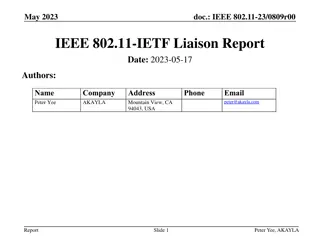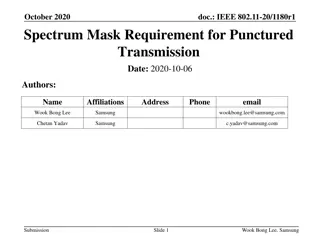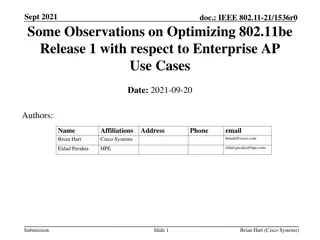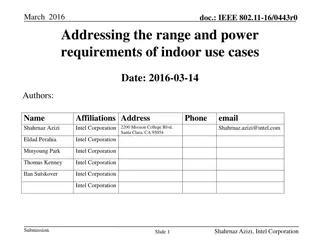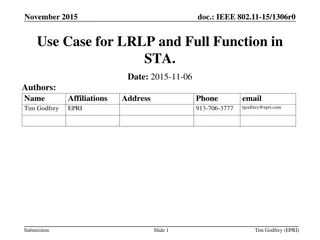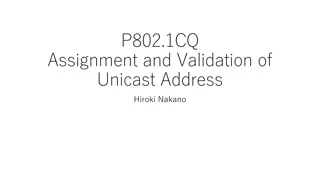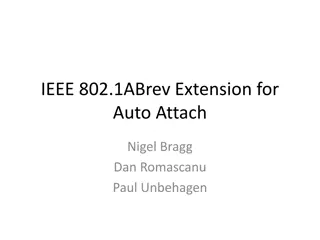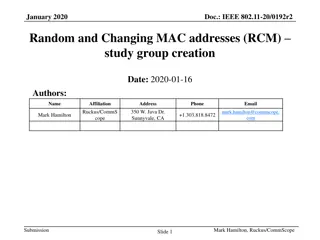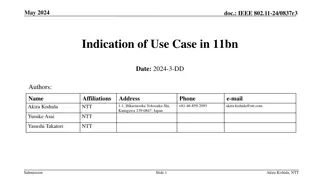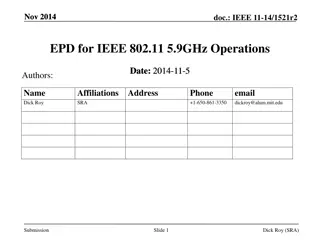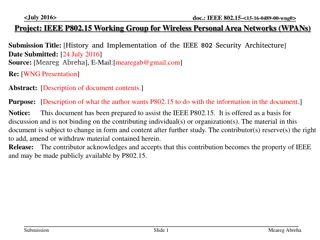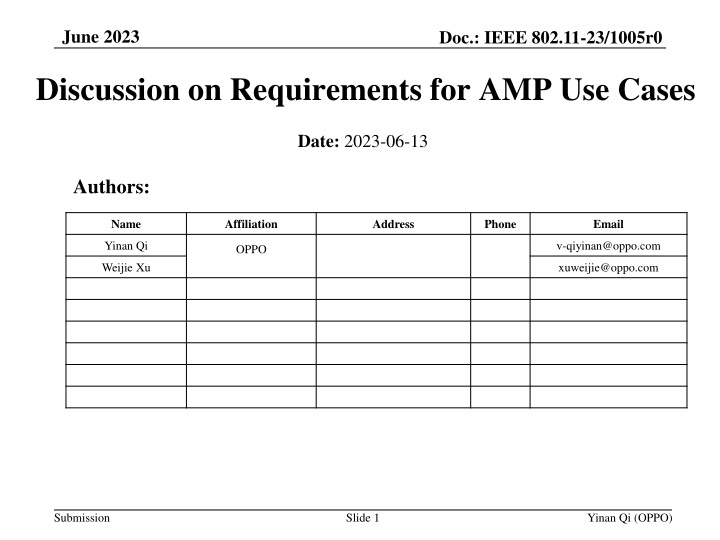
Requirements and Use Cases for IEEE 802.11-23/1005r0 in June 2023
This presentation discusses key requirements and use cases for AMP technology, covering smart manufacturing, data centers, smart homes, logistics, agriculture, power grids, and more. It also addresses payload sizes for various applications.
Download Presentation

Please find below an Image/Link to download the presentation.
The content on the website is provided AS IS for your information and personal use only. It may not be sold, licensed, or shared on other websites without obtaining consent from the author. If you encounter any issues during the download, it is possible that the publisher has removed the file from their server.
You are allowed to download the files provided on this website for personal or commercial use, subject to the condition that they are used lawfully. All files are the property of their respective owners.
The content on the website is provided AS IS for your information and personal use only. It may not be sold, licensed, or shared on other websites without obtaining consent from the author.
E N D
Presentation Transcript
June 2023 Doc.: IEEE 802.11-23/1005r0 Discussion on Requirements for AMP Use Cases Date: 2023-06-13 Authors: Name Affiliation Address Phone Email Yinan Qi v-qiyinan@oppo.com OPPO Weijie Xu xuweijie@oppo.com Submission Slide 1 Yinan Qi (OPPO)
Doc.: IEEE 802.11-23/1005r0 June 2023 Abstract The purpose of this presentation is to provide initial values for the key requirements. Submission Slide 2 Yinan Qi (OPPO)
June 2023 Doc.: IEEE 802.11-23/1005r0 Use Cases Defined in AMP TIG [1] Use case 1 Smart manufacturing: inventory, asset tracking/positioning, and environment/production line sensing and monitoring Use case 2 Data Center: environmental monitoring, facility monitoring and asset management Use case 3 Smart home: asset management, home environment monitoring and home security. Use case 4 Logistics and warehouse: goods tracking and inventory check Use case 5 Smart agriculture: monitoring of soil moisture, soil fertility, temperature, wind speed, plant growth etc., and controlling of the agricultural facilities Use case 6 Indoor positioning: positioning in giant shopping mall, factories, warehouses, etc. Use case 7 Smart Power Grid: sensing of sound, heat, pressure, etc., smart meter to achieve awareness of device/equipment status Use case 8 Fresh Food supply chain: Route the RTI, sense temperature etc. Submission Slide 3 Yinan Qi (OPPO)
June 2023 Doc.: IEEE 802.11-23/1005r0 Classification of Use Cases Classification based on service Sensor: smart manufacturing, data center, smart home, logistics and warehouse, smart agriculture, smart power grid, fresh food supply chain; Positioning/ranging: smart manufacturing, smart home, logistics and warehouse, fresh food supply chain, indoor positioning; Identification: smart manufacturing, data center, smart home, logistics and warehouse, smart agriculture, fresh food supply chain; Submission Slide 4 Yinan Qi (OPPO)
June 2023 Doc.: IEEE 802.11-23/1005r0 Maximum Payload Size (1/2) UC1 Smart Manufacturing: Identification: o 96/128 bits per device, EPC Tag Data standard, the length of the EPC number ranges from 96 bits to 496 bits, For intralogistics, EPC length of 96 bits is the most common EPC lengths. Positioning: o 224 = 96+128, EPC tag ID 96 + other information e.g., location information 128 o 256 = 128+128, AMP ID 128 + other information e.g., location information 128 Sensor: o 96 bits per device, for temperature and humidity monitoring, typically, the single packet size is 96bits Multiple payload sizes including 96/128/224/256 bits Considering potential additional payload, above payload size can be simplified as 128/256 bits UC2 Data Centre, UC4 Logistics UC5 Smart Agriculture and Warehouse UC7 Smart Power Grid and UC8 Fresh Food Supply: Identification: o 96/128 bits per device Positioning: o 224/256 bits per device Sensor: o 96 bits per device Multiple payload sizes including 96/128/224/256 bits Simplified as 128/256 bits Submission Slide 5 Yinan Qi (OPPO)
June 2023 Doc.: IEEE 802.11-23/1005r0 Maximum Payload Size (2/2) UC3 Smart Home: Sensor: o Multiple payload sizes including 8/96/128/224/256 bits Can be simplified as 8/128/256 bits UC6 Indoor Positioning: Identification: o 96 bits per device Positioning: o 224 = 96+128 bits per device Multiple payload sizes including 96/224 bits Simplified as 128/256 bits 8 per device, Alarm message Submission Slide 6 Yinan Qi (OPPO)
June 2023 Doc.: IEEE 802.11-23/1005r0 Peak Data Rate (1/3) UC1 Smart Manufacturing: Identification: o 96/128 bits per device with following options (assuming 920-925MHz, 250kHz channel bandwidth, 20 channel in total in China) Option 1: 100ms for one message, 20 parallel channels, up to 200 device identification capability per second 960/1280 bps Option 2: 10ms for one message, 20 parallel channels, up to 2000 device identification capability per second 9.6/12.8 kbps Option 3: 1ms for one message, 20 parallel channels, up to 20000 device identification capability per second 96/128 kbps Option 2 is preferred for the following reasons With less transmission time, shorter activation duration within one duty cycle is preferred by the AMP devices for less power consumption. Considering co-existence, AMP devices should occupy the channel as little as possible, especially when the number of AMP devices is large, which is the case for identification service such as inventory check. Submission Slide 7 Yinan Qi (OPPO)
June 2023 Doc.: IEEE 802.11-23/1005r0 Peak Data Rate (2/3) UC1 Smart Manufacturing: Positioning: o 224/256 bits per device with following assumption Option 1: 100ms for one message, 20 parallel channels, up to 200 device per second 2.24/2.56 kbps Option 2: 10ms for one message, 20 parallel channels, up to 2000 device per second 22.4/25.6 kbps Option 3: 1ms for one message, 20 parallel channels, up to 20000 device per second 224/256 kbps Option 2 is preferred for the following reason Even though AMP devices should occupy the channel as little as possible, the number of active AMP devices for positioning operation is small, e.g., only 2 in an ideal case, 10ms activation time is reasonable. Sensor: o 96 bits per device for single sample report Option 1: 1s for one message, 20 parallel channels, up to 20 device per second 96 bps for single sample report Option 2: 100ms for one message, 20 parallel channels, up to 200 device per second 0.96 kbps for single sample report Option 3: 10ms for one message, 20 parallel channels, up to 2000 device per second 9.6 kbps for single sample report Option 2 is preferred The sensing data reporting period can be very long, e.g., 1 hour/day or even longer so that even with longer activation time, the overall channel occupation percentage can be low. Submission Slide 8 Yinan Qi (OPPO)
June 2023 Doc.: IEEE 802.11-23/1005r0 Peak Data Rate (3/3) UC1 Smart Manufacturing: Conclusion o Up to 25.6 kbps o Assuming 50% transmission efficiency by taking PHY/MAC headers and other signalling into account, Overall data rate is 51.2 kbps Other use cases can assume the same peak data rate as UC1: Up to 51.2 kbps Submission Slide 9 Yinan Qi (OPPO)
June 2023 Doc.: IEEE 802.11-23/1005r0 Device Density (1/2) UC1 Smart Manufacturing: 1.5/m2 A typical car manufacturing plant takes up to 600 000 m2 in surface. Around 1 million units of materials are used in the manufacturing area, but they are not used at the same time. UC2 Data Centre 3/m2 Assuming the same density as UC1 but with 2-tier shelf UC3 Smart Home: 0.25/m2 Based on the deployment assumption of 1 AMP device every 2 meter. UC4 Logistics and Warehouse 1.5/m2 Assuming the same density as UC1 Submission Slide 10 Yinan Qi (OPPO)
June 2023 Doc.: IEEE 802.11-23/1005r0 Device Density (2/2) UC5 Smart Agriculture 1/m2 Assuming 1 device per meter for collecting sensing data UC6 Indoor Positioning: 0.25/m2 Based on the deployment assumption of 1 AMP device every 2 meter. UC7 Smart Power Grid: 10-2/m2 The device density is calculated based on an individual substation, where typically several hundreds of Ambient IoT devices are required to monitor the environmental parameters. UC8 Fresh Food Supply 1.5/m2 Same as UC1. Submission Slide 11 Yinan Qi (OPPO)
June 2023 Doc.: IEEE 802.11-23/1005r0 Coverage (1/3) Case1 Case2 Case3 Frequency (MHz) 920 920 920 EIRP of AP (dBm) 30 30 30 Receiver sensitivity of AP (dBm) -95 (Note 1) -95 -95 Antenna gain of IoT device (dBi) 2 2 2 Minimum receiving power for IoT device (dBm) Maximum communication distance from AP to IoT device (m) Backscattering loss at IoT device (dB) Low Noise Amplifier factor (dB) Maximum communication distance from IoT device to AP (m) *Notes: (1) Reuse the receiver sensitivity of an 802.11 ah AP (2) The minimum required signal power for an IoT device is -20dBm when the IoT device can t store power itself. It can be -30dBm when the IoT device has the capability of power storage. (3) -45 dBm is assumed as the sensitivity of ultra-low power receiver[15] [16] [17] . (4) LNA with 30 dBm gain is assumed to boost the backscattering signal, it can have ultra-low power consumption [21] [22] . -20 (Note 2) 10.33 -30 (Note 2) 32.67 -45 (Note 3) 183.71 5 0 103.31 5 0 32.67 5 30 (Note 4) 183.71 Submission Slide 12 Yinan Qi (OPPO)
June 2023 Doc.: IEEE 802.11-23/1005r0 Coverage (2/3) Case1 Case2 Case3 Frequency (GHz) 2.4 2.4 2.4 EIRP of AP (dBm) 27 27 27 Receiver sensitivity of AP (dBm) -95 (Note 1) -95 -95 Antenna gain of IoT device (dBi) 2 2 2 Minimum receiving power for IoT device (dBm) Maximum communication distance from AP to IoT device (m) Backscattering loss at IoT device (dB) Low Noise Amplifier factor (dB) Maximum communication distance from IoT device to AP (m) *Notes: (1) Reuse the receiver sensitivity of an 802.11 ah AP (2) The minimum required signal power for an IoT device is -20dBm when the IoT device can t store power itself. It can be -30dBm when the IoT device has the capability of power storage. (3) -45 dBm is assumed as the sensitivity of ultra-low power receiver. (4) LNA with 30 dBm gain is assumed to boost the backscattering signal, it can have ultra-low power consumption. -20 (Note 2) 2.8 -30 (Note 2) 8.87 -45 (Note 3) 49.85 5 0 39.60 5 0 12.52 5 30 (Note 4) 70.42 Submission Slide 13 Yinan Qi (OPPO)
June 2023 Doc.: IEEE 802.11-23/1005r0 Coverage (3/3) The coverage is bounded by the minimum value of energy harvesting coverage and communication coverage For case 2 with RF energy harvesting, i.e., type 1 device The minimum receiving signal power is -30dBm, which is based on the RF energy harvesting sensitivity, i.e., energy harvesting coverage For case 3 with solar power energy harvesting, i.e., type 2 device The minimum receiving signal power is -45dBm, which is based on communication coverage. However, backscattering is assumed here and this value is calculated to balance the UL and DL coverage. With active transmitter, the communication coverage can be assumed to be the same as WUR, i.e., -82dBm. Submission Slide 14 Yinan Qi (OPPO)
June 2023 Doc.: IEEE 802.11-23/1005r0 Requirements Peak device power consumption (mWatts) Maximum payload size (bit) Device density (per m2) Horizontal Positioning accuracy (m) Peak data rate (Kbps) Coverage (dBm) Others Type1: -30 Type2: -82 UC1: Smart Manufacturing 256 1 1.5 3 51.2 kbps Type1: -30 Type2: -82 256 1 3 1-3 51.2 kbps UC2: Data Centre Type1: -30 Type2: -82 UC3: Smart Home 256 1 0.25 1-3 51.2 kbps Type1: -30 Type2: -82 UC4: Logistics and Warehouse 256 1 1.5 3 51.2 kbps Type1: -30 Type2: -82 UC5: Smart Agriculture 256 1 1 10 51.2 kbps Type1: -30 Type2: -82 UC6: Indoor Positioning 256 1 0.25 1-3 51.2 kbps Type1: -30 Type2: -82 Type1: -30 Type2: -82 UC7: Smart Power Grid 256 1 10-2 10 51.2 kbps UC8: Fresh Food Supply Chain Note 1: Coverage is calculated based on AWGN Channel Note 2: Type 1: RF powered AMP device; Type 2: non-RF powered AMP device, e.g., thermal, solar, etc. Note 3: Others include requirements only applicable to a subset of use cases 256 1 1.5 3 51.2 kbps Submission Slide 15 Yinan Qi (OPPO)
June 2023 Doc.: IEEE 802.11-23/1005r0 Reference 1. IEEE 802.11-23/0436r8, Technical Report on support of AMP IoT devices in WLAN Submission Slide 16 Yinan Qi (OPPO)



